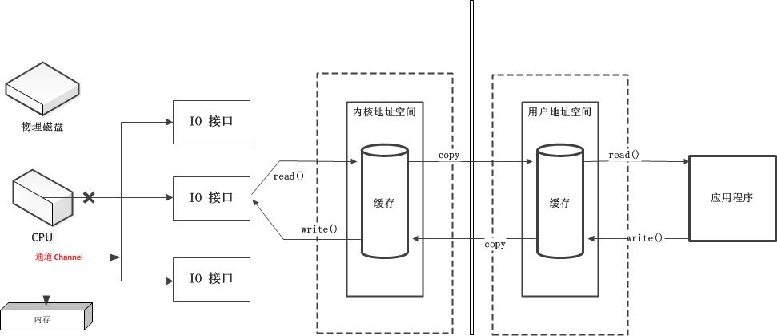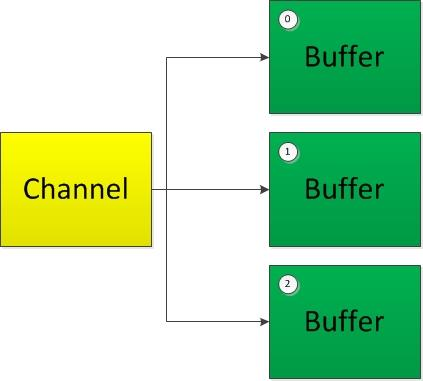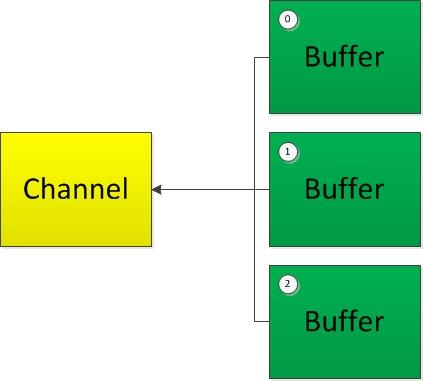通道(Channel):由 java.nio.channels 包定义的。Channel 表示 IO 源与目标打开的连接。
Channel 类似于传统的“流”。只不过 Channel本身不能直接访问数据,Channel 只能与Buffer 进行交互。

Java 为 为 Channel 接口提供的最主要实现类如下:
- FileChannel:用于读取、写入、映射和操作文件的通道。
- DatagramChannel:通过 UDP 读写网络中的数据通道。
- SocketChannel:通过 TCP 读写网络中的数据。
- ServerSocketChannel:可以监听新进来的 TCP 连接,对每一个新进来的连接都会创建一个 SocketChannel。
获取通道
获取通道的一种方式是对支持通道的对象调用getChannel() 方法。支持通道的类如下:
- FileInputStream
- FileOutputStream
- RandomAccessFile
- DatagramSocket
- Socket
- ServerSocket
在 JDK 1.7 中的 NIO.2 针对各个通道提供了静态方法 open()
在 JDK 1.7 中的 NIO.2 的 Files 工具类的 newByteChannel()
通道之间的数据传输
transferFrom()
transferTo()
分散(Scatter)与聚集(Gather)
分散读取(Scattering Reads):将通道中的数据分散到多个缓冲区中

聚集写入(Gathering Writes):将多个缓冲区中的数据聚集到通道中

Charset
编码:字符串 -> 字节数组
解码:字节数组 -> 字符串
通道的数据传输
将 Buffer 中数据写入 Channel
outChannel.write(buf)
从 Channel 读取数据到 Buffer
inChannel.read(buf)
//利用通道完成文件的复制(非直接缓冲区) @Test public void test1(){ long start = System.currentTimeMillis(); FileInputStream fis = null; FileOutputStream fos = null; //①获取通道 FileChannel inChannel = null; FileChannel outChannel = null; try { fis = new FileInputStream("1.png"); fos = new FileOutputStream("2.png"); inChannel = fis.getChannel(); outChannel = fos.getChannel(); //②分配指定大小的缓冲区 ByteBuffer buf = ByteBuffer.allocate(1024); //③将通道中的数据存入缓冲区中 while(inChannel.read(buf) != -1){ buf.flip(); //切换读取数据的模式 //④将缓冲区中的数据写入通道中 outChannel.write(buf); buf.clear(); //清空缓冲区 } } catch (IOException e) { e.printStackTrace(); } finally { if(outChannel != null){ try { outChannel.close(); } catch (IOException e) { e.printStackTrace(); } } if(inChannel != null){ try { inChannel.close(); } catch (IOException e) { e.printStackTrace(); } } if(fos != null){ try { fos.close(); } catch (IOException e) { e.printStackTrace(); } } if(fis != null){ try { fis.close(); } catch (IOException e) { e.printStackTrace(); } } } long end = System.currentTimeMillis(); System.out.println("耗费时间为:" + (end - start)); }
使用直接缓冲区完成文件的复制(内存映射文件)
//使用直接缓冲区完成文件的复制(内存映射文件) @Test public void test2() throws IOException{//2127-1902-1777 long start = System.currentTimeMillis(); FileChannel inChannel = FileChannel.open(Paths.get("1.png"), StandardOpenOption.READ); FileChannel outChannel = FileChannel.open(Paths.get("2.png"), StandardOpenOption.WRITE, StandardOpenOption.READ, StandardOpenOption.CREATE); //内存映射文件,缓冲区在物理内存中 MappedByteBuffer inMappedBuf = inChannel.map(MapMode.READ_ONLY, 0, inChannel.size()); MappedByteBuffer outMappedBuf = outChannel.map(MapMode.READ_WRITE, 0, inChannel.size()); //直接对缓冲区进行数据的读写操作 byte[] dst = new byte[inMappedBuf.limit()]; inMappedBuf.get(dst); outMappedBuf.put(dst); inChannel.close(); outChannel.close(); long end = System.currentTimeMillis(); System.out.println("耗费时间为:" + (end - start)); }
transferTo和transferFrom的使用来实现通道之间的数据传输(直接缓冲区)
@Test public void test3() throws IOException{ FileChannel inChannel = FileChannel.open(Paths.get("d:/1.mkv"), StandardOpenOption.READ); FileChannel outChannel = FileChannel.open(Paths.get("d:/2.mkv"), StandardOpenOption.WRITE, StandardOpenOption.READ, StandardOpenOption.CREATE); // inChannel.transferTo(0, inChannel.size(), outChannel); outChannel.transferFrom(inChannel, 0, inChannel.size()); inChannel.close(); outChannel.close(); }
分散和聚集:
@Test public void test4() throws IOException{ RandomAccessFile raf1 = new RandomAccessFile("1.txt", "rw"); //1. 获取通道 FileChannel channel1 = raf1.getChannel(); //2. 分配指定大小的缓冲区 ByteBuffer buf1 = ByteBuffer.allocate(100); ByteBuffer buf2 = ByteBuffer.allocate(1024); //3. 分散读取 ByteBuffer[] bufs = {buf1, buf2}; channel1.read(bufs); for (ByteBuffer byteBuffer : bufs) { byteBuffer.flip(); } System.out.println(new String(bufs[0].array(), 0, bufs[0].limit())); System.out.println("-----------------"); System.out.println(new String(bufs[1].array(), 0, bufs[1].limit())); //4. 聚集写入 RandomAccessFile raf2 = new RandomAccessFile("2.txt", "rw"); FileChannel channel2 = raf2.getChannel(); channel2.write(bufs); }
Charset 字符集:
获取所有支持的字符集:
@Test public void test5() { Map<String, Charset> map = Charset.availableCharsets(); Set<Entry<String, Charset>> set = map.entrySet(); for (Entry<String, Charset> entry : set) { System.out.println(entry.getKey() + "=" + entry.getValue()); } }
Charset 编码解码:
@Test public void test6() throws IOException { Charset cs1 = Charset.forName("GBK"); // 获取编码器 CharsetEncoder ce = cs1.newEncoder(); // 获取解码器 CharsetDecoder cd = cs1.newDecoder(); CharBuffer cBuf = CharBuffer.allocate(1024); cBuf.put("老王爱小琼"); cBuf.flip(); // 编码 ByteBuffer bBuf = ce.encode(cBuf); for (int i = 0; i < bBuf.limit(); i++) { System.out.println(bBuf.get()); } // 解码 bBuf.flip(); CharBuffer cBuf2 = cd.decode(bBuf); System.out.println(cBuf2.toString()); System.out.println("------------------------GBK解码------------------------------"); Charset cs2 = Charset.forName("GBK"); bBuf.flip(); CharBuffer cBuf3 = cs2.decode(bBuf); System.out.println(cBuf3.toString()); System.out.println("-------------------------UTF-8解码-----------------------------"); Charset cs3 = Charset.forName("UTF-8"); bBuf.flip(); CharBuffer cBuf4 = cs3.decode(bBuf); System.out.println(cBuf4.toString()); }




 本文详细介绍了Java NIO中的通道(Channel)概念及其主要实现类,包括FileChannel、DatagramChannel等,并展示了如何使用这些通道进行数据传输。此外,还探讨了直接缓冲区与非直接缓冲区在文件复制过程中的应用。
本文详细介绍了Java NIO中的通道(Channel)概念及其主要实现类,包括FileChannel、DatagramChannel等,并展示了如何使用这些通道进行数据传输。此外,还探讨了直接缓冲区与非直接缓冲区在文件复制过程中的应用。

















 468
468

 被折叠的 条评论
为什么被折叠?
被折叠的 条评论
为什么被折叠?








